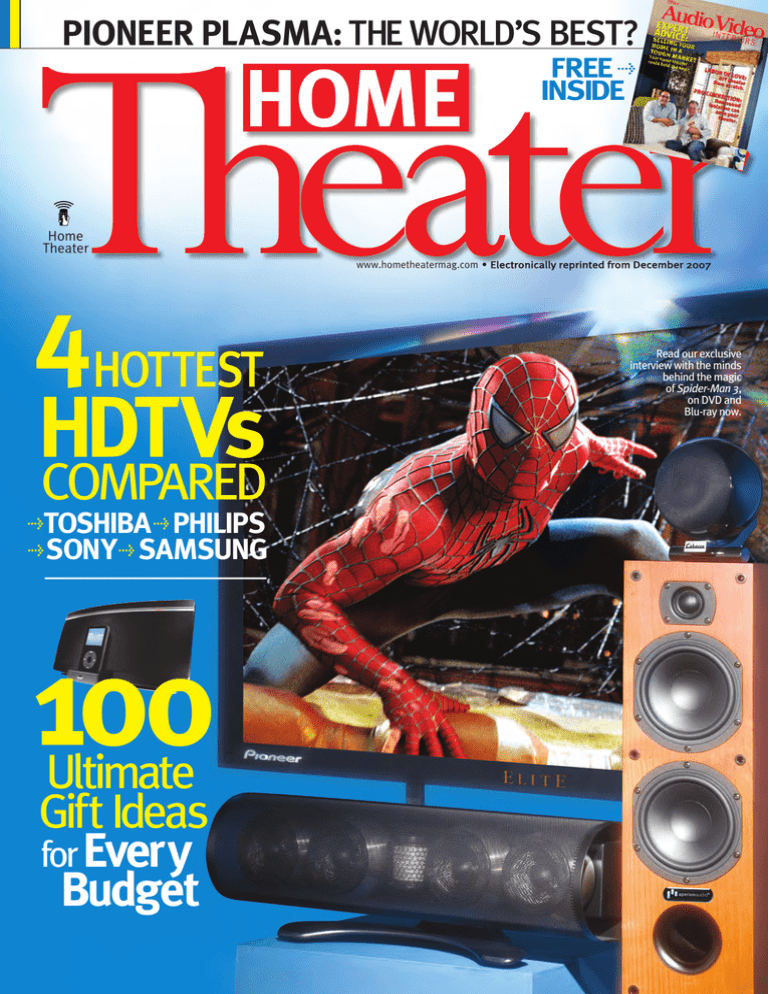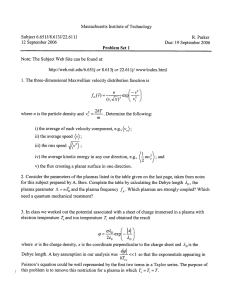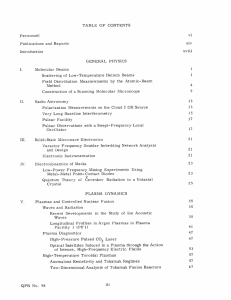
PIONEER PLASMA: THE WORLD’S BEST?
FREE >
INSIDE
Home
Theater
www.hometheatermag.com • Electronically reprinted from December 2007
4HOTTEST
HDTVs
COMPARED
TOSHIBA > PHILIPS
> SONY > SAMSUNG
>
100
Ultimate
Gift Ideas
for Every
Budget
Read our exclusive
interview with the minds
behind the magic
of Spider-Man 3,
on DVD and
Blu-ray now.
from the
test bench
HIGH PERFORMANCE
$$$—$$$$
Pioneer Elite KURO
PRO-110FD Plasma HDTV
tossed that latter term around
before. We were wrong.
Fast-forward to last summer.
Pioneer had a name for this new
leap in plasma technology, KURO,
the Japanese word for black. Their
press conference for the production
models of this new line amazingly
had all the plasmas lit from behind.
Could it be that they didn’t want to
show their plasmas in a totally dark
room (a trick stolen from every
LCD manufacturer)? Some of us,
myself included, worried that the
promise of this leap was watered
down so that it was merely an
incremental improvement. Manufacturing in large numbers tends to
do that. So we waited.
Now
BY GEOFFREY MORRISON
Forgive my dipping into hyperbole for the title, but there really
wasn’t another way to go. It’s not
just the fact that the PRO-110FD
creates a beautiful image. It’s that
the image it creates is such a step
above every other flat panel on the
market that it is not even comparable. There’s that hyperbole again.
I’ll stop and let the performance
speak for itself.
CEATEC 2006
A little over a year ago, in a cramped
demo room at CEATEC in Tokyo,
Pioneer showed something that
really got my nerd radar beeping.
In the darkened room, you could
make out two panels. One had that
subtle and comforting glow that
any flat panel has when displaying
“black.” The other panel was clearly
off. Then an image appeared—on
both screens. It was a ruse; the other
panel wasn’t off at all. It was on. The
black level was that good—CRT
good. We, as TV reviewers, have
Home Theater / December 2007 > www.hometheatermag.com
Let’s start with the big one. The
black level, as measured in our
lab, is 0.004 foot-lamberts. For
comparison, the best black level
we’ve measured on a plasma previously was 0.012 ft-L, which was a
Panasonic TH-42PX60U. The best
black level on an LCD we’ve ever
measured was 0.006 ft-L on the
Sharp LC-52D92U (or the 0.005 ft-L
from the KDL-46XBR4 in this
issue, sort of. See that review on
page 72). So that 0.004 ft-L is
lower than any other flat panel
we’ve ever measured. While excellent, it’s still not black. As in, you
can still see when the TV is on or
tell the black letterbox bars from
Photography by Cordero Studios / Screen image courtesy of Paul Dimalanta
Greatest flat panel ever.
from the
test bench
the dark room beyond. I know, I’m
asking for a lot. I mean, you’d have
to get a projector and a pretty big
screen to reach a better black level
(or, admittedly, a CRT). But as
impressive as that measurement is,
it isn’t even the amazing part.
At 4,020:1, the PRO-110FD’s
full-on/full-off contrast ratio is so
good, it is nearly double that of the
next best flat panel. Read that again.
Double. This isn’t an incremental
improvement, as we’ve seen with all
flat panels over the past few years.
This is a marked jump. And that’s
comparing it with the best of the
rest. If you take the average contrast
ratio of current flat panels, it’s three
or four times better. The irony is
that plasmas aren’t supposed to
have a good full-on/full-off contrast
ratio. It’s in their very design not to.
I’ll come back to that, as this still
isn’t the amazing part.
ANSI contrast ratio, which is the
measurement of eight 100-percentwhite and eight 0-percent-black
squares arranged in a checkerboard pattern, provides a sort of
worst-case scenario of what you’ll
see on the screen in terms of contrast ratio. The measured ANSI
contrast of 3,239:1 is almost three
times better than the best plasmas
and most LCDs, and a full 50 percent better than the highest we’ve
previously measured. And even all
of that pales in comparison with
this next measurement.
All of these tests so far aren’t
even letting a plasma perform at
its best. All plasmas have built-in
limiters, so things like a 100-IRE
full-white field won’t cause the TV
to melt. So their full-on/full-off
numbers, at least how we measure them, are misleadingly low.
This is why I always mention what
a plasma can do on a 100-IRE
window (roughly 25 percent of
NUVISION
NVX32HDU
LC HD MONITR
PIONEER
ELITE
KURO PRO-110FD
PLASMA HDTV
AT A GLANCE
PIONEER ELITE KURO PRO-110FD PLASMA HDTV
> CONNECTIONS
Inputs:
Video:
Audio:
> FEATURES
Type:
Screen Size (diagonal, inches):
Native Resolution / Aspect Ratio:
Half Life:
Wall Mount or Stand Included?:
Dimensions (H x W x D, inches):
Weight ( pounds):
Price:
Plasma
50
1,920 by 1,080 / 16:9
60,000 hours
Stand
28.03 x 56.84 x 4.72
99.4
$5,999
HDMI (4, v1.3), PC-RGB
(1), component video
(2-shared), S-video
(1-shared), composite
video ( 3-shared)
Stereo analog ( 5)
Outputs:
Video:
None
Audio:
Optical (1), stereo analog (1), 1/4 headphones (1), speaker
level (2)
Additional:
RF (2), USB (1), Ethernet (1),
CableCARD (1)
HT Labs Measures: Pioneer Elite KURO PRO-110FD Plasma HDTV
0.004
16.08
> Full-On/Full-Off Contrast Ratio—4,020:1;
ANSI Contrast Ratio—3,239:1
> Measured Resolution with the Leader LT-446:
480: 480 (per picture height)
720p: 720 (pph)
1080i: 1,080 (pph)
> DC Restoration (poor, average, good, excellent):
Good
> Color Decoder (poor, average, good, excellent):
Excellent
> Measured Color Points:
Red Color Point: x=0.655, y=0.331
Green Color Point: x=0.294, y=0.620
Blue Color Point: x=0.149, y=0.066
The left chart shows the PRO-110FD’s gray scale relative to its color temperature at various levels of intensity, or brightness (20 IRE is dark gray; 100 IRE is bright
white). The gray scale as set by the factory, in the
Mid-Low color-temperature mode and the Pure picture mode, measures warm across most of the grayscale range, with the brightest of images measuring
slightly cool. After making adjustments using the
Photo Research PR-650, the gray scale measures
better, although there is still a dip warm at the low
end and a dip cool at the high end.
The right chart shows the gray scale (or color
temperature) relative to the color points of the display’s red, green, and blue phosphors. These are
somewhat close to those specified by SMPTE. Red
and green are slightly oversaturated. Blue is very
slightly greenish-blue.
After calibration, and using a full-field 100-IRE
white (16.08 foot-lamberts) and a full-field 0-IRE
black (0.004 ft-L), the full-on/full-off contrast ratio
was 4,020:1. Using a 16-box checkerboard pattern
(ANSI contrast), the contrast ratio was 3,239:1. With
a 100-IRE window the PRO-110FD was able to produce 42.58 ft-L, for a “real world” contrast ratio of
10,645:1. (It is normal for a plasma to have lower
light output on a full white field versus a white
window).—GM
the screen), which is a more accurate representation of the contrast
ratio you’re seeing when you’re
watching TV or movies. LCDs
don’t need this test because they’ll
measure identical to their full-on/
full-off numbers. That’s just how
they work. With this test—and
this is what it looks like when
you’re watching actual video—the
contrast ratio is 10,645:1. This is
above and beyond any other flat
panel on the market, by far. In fact,
there are only a few displays of any
type on the market that can boast
this kind of contrast ratio without
“dynamic” helpers such as irises or
adjustable backlights, and all of
them are front projectors.
Even the vaunted CRT would
find it difficult to beat this beast, as
CRTs had notoriously bad ANSI
contrast measurements (although,
admittedly, the best had an unmeasurably low black level).
^ Fully backlit and
direct input access?
The remote is almost
as good as the TV.
How?
Plasmas create light with time.
This is weird, so bear with me. A
plasma’s cells (pixels, if you will)
cycle hundreds of times per
second. If you want a bright pixel,
the cells fire and create light
during most or all of the cycles.
If you want a dark pixel, they don’t
fire as often, or at all. Each firing
is the same brightness; it’s just
how many times per second the
cells fire that determines the brightness of the pixel.
The problem is, even when a
pixel is “off,” it isn’t really off. It’s
like a 10-year-old hyped up on caffeine and sugar. It’s all bouncing
around and ready to fire off if you
let it. So even an “off ” pixel lets off
a little light because of its excitement. In these new KURO plasmas,
Pioneer reduced the idle luminance (that “off ” stage) by 80 percent. Thus, the absolute darkest the
pixel (and, therefore, the plasma)
could be was reduced by roughly
the same amount. Case in point:
The best of their previous generation, the PRO-FHD1, had a black
level of 0.032 ft-L. Now, they’re
down to 0.004 ft-L.
[
HIGHLIGHTS
Everything
Previous Pioneer plasmas could
pass this picky test. So, it’s odd that
this one doesn’t.
With 480i, the PRO-110FD also
performed well. It picked up 3:2
with no problem. With the DVD
version of the Silicon Optix disc, the
processing across the board was
excellent. The rotating-bar pattern
was well above average and amongst
the best I’ve seen (as in very few
jagged edges on diagonal lines). The
waving flag was nearly devoid of any
jagged edges. With the test scene
from chapter 2 of The Fifth Element,
the professor’s beard appeared
detailed, although I’ve seen displays
that can pull more detail from this
disc. It was a bit noisier than I’ve
seen, but the 3DNR noise reduction
set to Low alleviated much of this,
without softening the image.
It Doesn’t Stop There
If the contrast ratio was all this
TV was good at, it would still be
one of the best flat panels ever
made. But that’s not all it’s good
for. Over HDMI, the PRO-110FD
deinterlaces 1080i correctly, as
well as picking up the 3:2 sequence
in 1080i material (as tested with
the Silicon Optics Benchmark HD
DVD). It can also reproduce a
one-pixel-on/one-pixel-off pattern
with 1080 signals. Over component, oddly, it’s another story.
The 1080i is deinterlaced properly,
but it neither picks up the 3:2, nor
can it do the one-pixel-on/off.
Color
OVERALL RATING
PIONEER ELITE KURO PRO-110FD PLASMA HDTV
Build Quality
Value
Features
Performance
> Feels like a $6,000
product should
> It sure is crazy
expensive
> 72-hertz mode is
great
> You have to see it to
believe it
> Good luck finding
burn-in
> But for this level
of performance…
> Four HDMI inputs
> Near-perfect processing
Ergonomics
> Backlit remote
> Direct input access
96
EXCELLENT
91
GOOD
98
EXCELLENT
98
EXCELLENT
96
EXCELLENT
General information
Elite KURO PRO-110FD Plasma HDTV, $5,999 > Pioneer, (800) PIONEER, www.pioneerelectronics.com
Dealer Locator Code PIO
Home Theater / December 2007 > www.hometheatermag.com
96
As you can see in the measurements
box, the color points are pretty
close to accurate, with just a touch
EXCELLENT
It is, without a doubt, one of the
greatest flat-screen TVs ever
made. It really is that much
better than everything else out
there. How’s that for hyperbole?
of oversaturation.With regular video,
such as Batman Begins on HD DVD,
the fleshtones looked pleasingly natural.
There’s also an extra level of calibration possible with this set called
ISFccc (Certified Calibration Configuration). It was created with input
from the Imaging Science Foundation. Within it, a trained calibrator
can nudge the color points closer to
accurate. Full adjustment isn’t possible, as they say it can make the image
wonky (my word, not theirs). The
points are pretty close to start with,
so any improvement is a bonus. The
coolest part is the ability to adjust 10
different brightness steps of the gray
scale separately, so you can even out
most bumps in the gray scale. Again,
it already tracks pretty well, but being
able to even it out even more sure
doesn’t hurt.
Like most Pioneer plasmas, this
model can increase its refresh rate to
72 hertz. This allows a 3:3 pulldown
to happen when you send it 24p.
Consequently, there’s no more 3:2
jutter. This doesn’t mean it will look
smooth, just not as juttery and jerky as
happens with a normal 3:2 sequence.
I did a GearWorks on this in the June
2007 issue, which you can find
online, or there’s a post somewhere
in my blog that is basically the same
article. (Woot! Self-plagiarism.)
While the overall 3:3 effect isn’t life
changing, it is noticeable and adds that
little bit extra. The RGB input maxes
out at 1,360 by 768. Lame. But you
can do PC over HDMI if you’re so
inclined, up to 1,920 by 1,080.
So, how does all this look? In spite
of being the most obnoxious disc to
use ever made, Pirates of the Caribbean:
Curse of the Black Pearl is a great demo.
There are a lot of brightly lit scenes
with dark areas and dark scenes with
bright spots. On most displays, the
latter can seem flat, but on the PRO110FD, the bright spots really
popped. Highlights were actually
brighter than other areas of the picture. When was the last time you saw
that? In contrast (a pun), the bright
scenes had dark areas that were actually dark. Color was vibrant and natural. The Lobsterbacks’ uniforms
were a rich red in contrast to the blue
sky, which was a lovely shade of skyblue. You can make out individual
hairs on heads and even see texture
in the clothing.You’re not going to see
a TV look much better than this.
Honey, How Much Can We
Get for the Kids?
At $5,999 the Pioneer is roughly
twice as expensive as a 50-inch Panasonic plasma or Sharp LCD. However, as you’ve seen, the performance
is well more than twice as good. But
before you call that loan shark, consider this, the $3,500 Pioneer PDP5080HD is the same size and will
have nearly identical performance.
(It’s in the KURO line as well.) The
catch? It’s “only” 768p; but from
where you’re sitting, you probably
won’t be able to see that difference
anyway.
It’s rare that I’m impressed by a
display, and I don’t think I’ve ever
been this impressed by a flat
panel. A jaded reviewer I may be,
but even I can’t help but be
impressed by this plasma. The
PRO-110FD measures, performs,
and looks better than any other
flat panel on the market, and it’s
one of the best displays of any type
available now. No matter what
type of TV you’re looking to buy,
you owe it to yourself to see how
one of these looks, just for comparison. On second thought,
maybe that’s a bad idea.
Posted with permission from the December 2007 issue of Home Theater ® www.hometheatermag.com. Copyright 2007, PRIMEDIA Inc. All rights reserved.
For more information about reprints from Home Theater, contact Wright’s Reprints at 877-652-5295
40833



